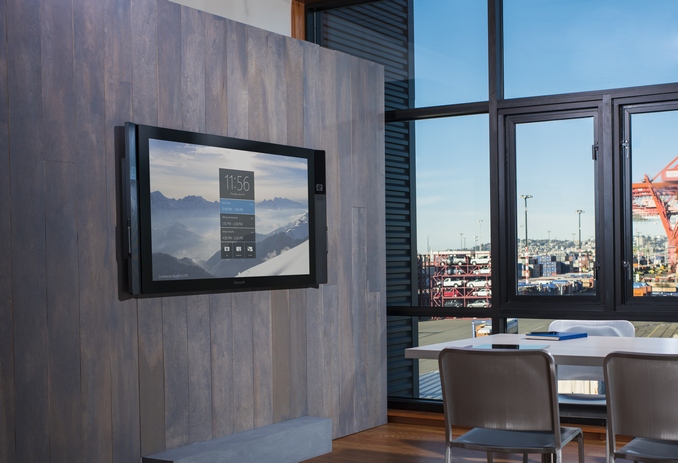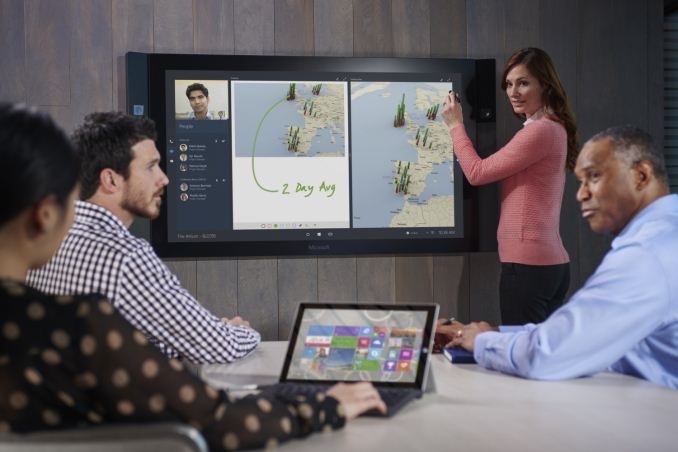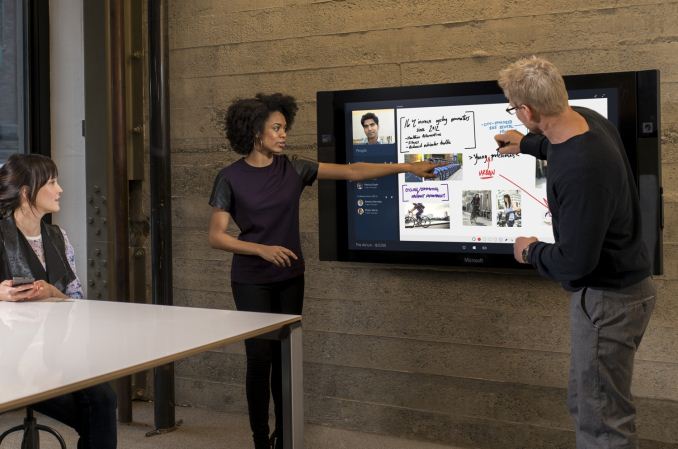Microsoft Surface Hub Availability And Specifications Announced
by Brett Howse on June 10, 2015 6:20 PM EST- Posted in
- Systems
- Microsoft
- Surface Hub

Today Microsoft announced more news regarding the Surface Hub, which is their large-screen collaboration device. Built specifically for the business conference room, the Surface Hub packs some impressive features inside.
The first bit of news though is that the Surface Hub will be available for pre-order starting on July 1st, and shipments will begin in September. It will initially be available in twenty four markets, with the United States, Canada, Australia, Austria, Belgium, Denmark, France, Finland, Germany, Ireland, Italy, Japan, Luxembourg, the Netherlands, New Zealand, Norway, Portugal, Qatar, Singapore, Spain, Sweden, Switzerland, United Arab Emirates and the United Kingdom all getting first dibs on this new device. The prices will seem steep to anyone who does not often furnish a conference room, with the smaller 55-inch model being offered for $6999, and the 84-inch model will sell for $19,999.
That is not inexpensive at all, but it should actually be less expensive that some of the other conference room solutions, and yet pack in technology that they can’t offer. Here is a table of the listed specifications:
| Microsoft Surface Hub | ||||||
| Surface Hub 55" | Surface Hub 84" | |||||
| Dimensions | H: 31.75" (806.4 mm) W: 59.62" (1514.3 mm) D: 3.38" (85.8 mm) |
H: 46.12" (1171.5 mm) W: 86.7" (2202.9 mm) D: 4.15" (105.4 mm) |
||||
| Weight | 105 lbs (48 kg) | 280 lbs (127 kg) | ||||
| CPU | Intel Haswell (4th Gen) Core i5 | Intel Haswell (4th Gen) Core i7 | ||||
| GPU | Intel HD 4600 | NVIDIA Quadro K2200 640 CUDA Cores | ||||
| RAM | 8 GB | 8 GB | ||||
| Storage | 128 GB SSD | 128 GB SSD | ||||
| Display | 55" 1920x1080 @ 120 Hz 1300:1 Contrast Ratio 100-point Multi-touch Three Simultaneous Active Pens Projective Capacitance optically bonded sensor |
84" 3840x2160 @ 120 Hz 1400:1 Contrast Ratio 100-point Multi-touch Three Simultaneous Active Pens Projective Capacitance optically bonded sensor |
||||
| Networking | Wired 1 Gbps Wireless 802.11ac Bluetooth 4.0 LE NFC Reader Miracast Enabled |
|||||
| Ports | Internal PC (1) USB 3.0 (bottom) + (1) USB 3.0 (side access) (2) USB 2.0 Ethernet 1000 Base-T DisplayPort Video Output 3.5mm Stereo Out RS232 Serial Port RJ11 Connector for system level control Alternate PC (2) USB 2.0 type B output, connection for: Camera Sensors Microphone Speakers Touchback™ (1) DisplayPort Video Input Guest PC DisplayPort Video Input HDMI Video Input VGA Video Input 3.5mm Stereo Input (1) USB 2.0 type B Touchback™ Output |
|||||
| Sensors | (2) Passive Infrared Presence Sensors Ambient Light Sensors |
|||||
| Speakers | (2) Front Facing Speakers | |||||
| Microphone | High Performance, 4 Element Array | |||||
| Cameras | (2) 1080p @ 30fps | |||||
| Price | $6,999 | $19,999 | ||||
The first notable aspect is the displays, which both feature optically bonded projective capacitance sensors to minimize reflections. Both models also can support an insane 100 points of concurrent multi-touch, and three simultaneous pen inputs. The 55-inch model is a 1920x1080 panel, and the 84-inch is a 3840x2160 resolution, and both have a refresh rate of 120Hz. The touch digitizer is also 120Hz, and according to Microsoft it makes the experience much more akin to an analog counterpart.
These will not be just displays to project to either. Powering the Surface Hub is a custom version of Windows 10, which is run on a Haswell Core i5 on the smaller model and a Core i7 on the larger one. The 84-inch model also jumps from integrated graphics to the NVIDIA Quadro K2200, which is a Maxwell based GM107 GPU with 640 CUDA Cores. Both Hubs come with 128 GB of SSD storage and 8 GB of RAM, as well as Gigabit Ethernet and 802.11ac, with Bluetooth 4.0 LE, NFC, and Miracast available.
They will also feature two front-facing stereo speakers, a four element microphone, two 1080p cameras each, as well as passive infrared presence sensors and ambient light sensors.
I think the steep price is going to keep these devices closely locked to their target audience of conference and meeting rooms. It would be very cool to have an 84-inch Windows 10 powered Smart TV, but for $20,000 it would be a tough sell.
I’ve asked a couple of questions to Microsoft to get some more details about this device though, including its ability to handle HDMI 2.0 inputs and a few other things, so once I hear back I’ll update the post.
Source: Microsoft












36 Comments
View All Comments
K_Space - Wednesday, June 10, 2015 - link
Any idea who's supplying the panels?Brett Howse - Wednesday, June 10, 2015 - link
Not sure, the panel is the only thing not assembled by Microsoft.Morawka - Wednesday, June 10, 2015 - link
Looks to be LGblaktron - Wednesday, June 10, 2015 - link
I'm pretty sure the best part of this is the built in RJ11 and RS232 ports. The application for these devices because of this is actually pretty staggering, you can have them control all sorts of stuff directly, like existing x10 automated offices etc.quiksilvr - Wednesday, June 10, 2015 - link
These prices make no damn sense at all These don't even have current generation chips and the 55" has a Core i5 processor. They only has 8GB of RAM! I understand the touchscreen aspect is the main draw here, but these prices make no sense. Make that 55" 4K, give it a current generation Core i7 chip with 16GB of RAM and 512GB SSD and a $4999 price point. And do the same with the 84" but give it a $7999 price point.bminor13 - Wednesday, June 10, 2015 - link
Prices are driven by demand, not by component cost. According to the article, "That is not inexpensive at all, but it should actually be less expensive that some of the other conference room solutions, and yet pack in technology that they can’t offer". By their research, these price points do make sense. What research of current conference room technologies and their costs do you have to offer that counter this claim?Additionally, the price of this device has to cover the costs of development, not just components. As this will probably not be as high volume a device, as, say, the Surface tablets, the margin needs to be much higher to cover those costs.
Can you explain the need for the additional hardware specs you list? What would having 16GB vs 8 allow the device to do? Does the increased SSD size fill a specific need?
mpschan - Wednesday, June 10, 2015 - link
Completely agree. There's nothing a conference room PC needs to do that requires 16GB of ram. Applications needing more ram would likely not be installed on the PC.at80eighty - Wednesday, June 10, 2015 - link
you could be doing analytics reviews & brainstorming - many applications in the analytics & BI field would gobble 16GB without blinkingishould - Wednesday, June 10, 2015 - link
I think he's looking at the maximum performance, like he would use it as an all-in-one akin to a giant iMac. Games would work better with 16GB of RAM, but that won't be your bottleneck with that GPU. If it had a PCIe slot that'd be a different story, but the market for that just isn't there.WorldWithoutMadness - Wednesday, June 10, 2015 - link
It's plentiful for presentation. You don't play games or demo weird stuff on it. You write stuff on it!If you want to demo a rendering, that's what the ports are for.
It's well thought product, you're just showing your incomprehension on what is written in the spec table.